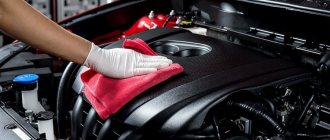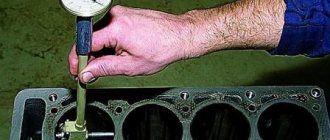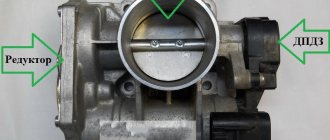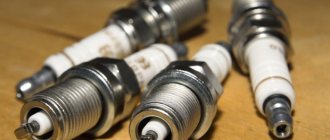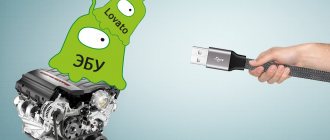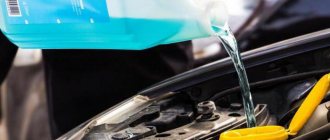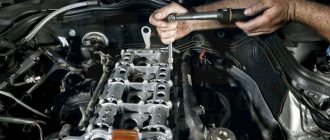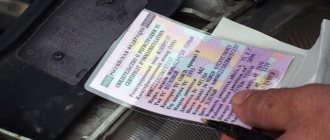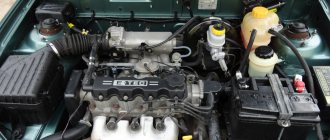11.05.2019
| (No votes) |
Issues discussed in the material:
- Why do you need car engine diagnostics?
- When should you perform engine diagnostics?
- What are the main stages of diagnosing a car engine?
- How much will this work cost?
An engine is a mechanism that converts the energy of any fuel into mechanical energy. The main component of the car, which determines its most important characteristics, is the internal combustion engine. Alas, even a caring owner will sooner or later have problems with his car engine. It is very important to localize the fault in time, for which there are certain stages of engine diagnostics.
Why do you need car engine diagnostics?
A car engine is quite complex, so its reliable operation is only possible with high-quality care and maintenance. You can verify the serviceability of all components and assemblies of the motor only through its diagnostics, which is carried out in several stages. This also needs to be done for preventive purposes at certain intervals, calculated either by calendar or by the mileage of the car.
The psychology of most people is such that they seek medical examination only in case of serious problems. It often happens that it is too late for effective treatment of the disease. They try to ignore minor ailments - tingling, slight pain - and wait until they go away on their own. However, such symptoms may be evidence of serious processes occurring in the body. And only a complete examination can give a detailed picture of a person’s health status.
Likewise, the power unit of a car gradually wears out, but it cannot tell its owner about it. Modern cars are equipped with advanced self-diagnostic devices. All information about the vehicle's condition is available on the on-board computer display. However, such systems are mainly equipped with expensive cars. Also, not all information collected by self-diagnosis is displayed to the user. The majority of owners of budget cars are forced to diagnose the engine themselves. It consists of a number of stages, each of which is important for assessing the situation.
We recommend
“Restoring a car after an accident: stages, choosing a service station, nuances” Read more
Computer engine diagnostics
Computer diagnostics of passenger car engines is necessary to find out:
- how worn out the engine is;
- how to make its work as efficient as possible;
- how to fix the breakdown so that the power unit works normally.
When conducting computer diagnostics at a service station, the technician uses a scanner, reader or stand to read error codes. After this, the obtained data is analyzed. Then, after consultation with a mechanic, the car owner chooses the most suitable method to eliminate the breakdowns that have arisen. Also, computer diagnostics of a car engine allows you to prevent the occurrence of malfunctions in the future.
On some cars, most often inexpensive ones, the settings are not made entirely correctly at the factory at the time of production of the car. For example, software can prevent a car from reaching its full potential, making it more difficult to operate. Fortunately, this is easy to fix. First of all, computer diagnostics of the car engine is carried out, during which factory defects are identified. Also, using a diagnostic tool, you can do chip tuning, that is, reprogram the vehicle parameters set by the manufacturer.
For example, it is possible to reconfigure the central electronic unit to optimize it for the selected configuration. With the help of chip tuning, you can adjust the idle speed, as well as adjust the power system. The addition of plugins will allow you to program the electronics so that it matches the interface of a car from a new family (even if such a car has not yet been released, and it is only planned for the near future).
The system automatically detects differences, meaning you don’t have to manually adjust the parameters.
All electronic systems for diagnosing a car engine are divided into 2 types depending on the following parameters:
- execution;
- functionality.
The first type includes independent scanners. These are small devices with a display as well as a port. Such devices can be directly connected to the car and immediately read data. This also includes adapters that can function together with a computer connected to an electronic control unit (or machine sensors via a cable).
We recommend
“Is it possible to mix coolants and what is the cost of the risk?” Read more
The second type of electronic diagnostic systems includes:
- Devices used in dealerships . They are made by car manufacturers. Such devices are 100% compatible with your car, no matter what brand and model it is. With their help, you can program the electronic control unit the way you need.
- Branded devices . They are produced by third-party companies and are intended for a specific make or model of car.
- Multi-brand equipment . It can be used for any car (you can also find devices on sale that are only suitable for American, German, Japanese, Korean, and so on cars).
Of course, the functionality of dealer equipment for computer diagnostics is extremely wide. However, even with the help of even the most ordinary electronic scanner, you can get all the information about the state of the power unit.
It is important to carry out computer diagnostics of a car engine on every car. The most important thing is that such testing has many advantages compared to standard analysis. Here are the main advantages of this diagnostic method:
- High accuracy and efficiency . It only takes 30 minutes to fully diagnose your car. And the computer will spend 2-3 minutes testing one node. At the same time, it will collect data on all failures and breakdowns. That is, the car owner will receive complete information about the condition of his car after the received data is decrypted by a car service employee. Then a repair plan is selected. Diagnostics of the engine of a diesel car (or gasoline) allows you to reconfigure the on-board electronics. For example, you can adjust the idle speed, adjust parameters in the fuel system, optimize the car for the selected configuration, install new software, and the like.
- Prevention of possible failures . Thanks to computer diagnostics of a car engine, you can find out both about breakdowns that have already occurred, and about problems that you will encounter in the future. By studying the data obtained during diagnostics, you can eliminate serious expenses for major repairs. This is easy to do: immediately replace the worn part. Such testing reduces the risk of sudden vehicle breakdown while driving. Only computer diagnostics of a car engine will allow you to detect and eliminate problems that exist in your car. In what cases is this procedure mandatory:
- You are going to travel by car . If you are planning a long trip on new routes in the near future, you should go to a service station to have your car's engine diagnosed. During testing, it will become clear which elements need to be replaced, and whether there are any breakdowns that require urgent repair. This is the only way you can protect yourself from a sudden car breakdown on a highway where there is not a single car service center.
- Are you planning to purchase a used car?. The money spent on car engine diagnostics will quickly pay off. After all, there are often cases when, when selling a vehicle, the owner does not talk about existing problems.
Only computer testing will identify all faults. And it is quite possible that you will refuse to purchase such a car. The technician at the service station will check all components of the vehicle and inform you about any breakdowns. Also, such diagnostics will show whether the car was involved in serious road accidents, what breakdowns already exist, and which ones may appear in the near future. - For prevention . Even if it seems to you that the vehicle is working properly, professionals advise regularly diagnosing the car’s engine. After all, testing will allow you to find out which elements of the car have worn out and can lead to a traffic accident. To be confident in your car, you should carry out engine diagnostics at least once every six months.
Differences in diesel engine diagnostics
Diagnostics of a diesel car engine or its components is a longer undertaking compared to the same testing of a power plant running on gasoline. You will need not only a special device, but also a master with extensive experience. In addition, it is necessary to use special diagnostic methods.
Why is diagnostics of a diesel car engine considered more difficult? The fact is that a gasoline engine has few system parameters, and a car mechanic can immediately determine the cause of the breakdown. For example, the composition of the fuel mixture in a diesel engine is much wider. This means that it will be quite difficult to determine whether the mixture is lean or rich in the selected mode. The specialist who conducts the diagnosis will have to analyze many indicators. This procedure is similar to the actions of a detective who, among several suspects, identifies the real criminal.
The most difficult thing to detect is breakdowns that occur from time to time in only one operating mode. When there are no clues, it is recommended to contact a specialist in diagnosing a diesel engine of a car with extensive experience; only he can help in this situation. The scanning device used must also be a professional one. The ideal option is that after a couple of trips, a master diagnostician will compare the key operating parameters of the engine systems and identify the malfunction. However, there are often cases when a specialist is forced to use several techniques at once in order to detect a breakdown.
Diagnosing other systems of a diesel car will not be so difficult. However, this work will require special equipment. For example, before you begin to unscrew and inspect the glow plugs, you need to take measurements and find out the voltage and resistance. What equipment will be needed in this case? It is best to use a current sensor. It is connected, and then the compression is measured.
Most often, a separate unit is responsible for controlling the candles. The sensor is attached to its supply wire, and then the total electrical current consumption is determined. If consumption drops sharply, it means that several candles have failed. Let's move on to the next step: checking these candles.
The vacuum system on diesel cars is more complex than the same system on gasoline cars. To make sure that it is airtight, you will have to use a fog machine. If smoke leaks out, there is a leak. Using a smoke machine, you can check whether the intake tract of the supercharging system is sealed.
The control part of the vacuum-type pressurization system is checked using several diagnostic methods at once. First, a vacuum gauge is used, which is connected to the system in several places. Then the data obtained is compared with the scanner readings about the control effect on the solenoid, as well as the boost pressure.
The differential pressure sensor allows you to know whether the diesel particulate filter is functioning properly. On-board diagnostics of a diesel vehicle of this unit is quite developed. Therefore, the information received will be 100% accurate. If the back pressure is high, then it is time to install a new filter.
It is also easy to diagnose the functioning of the Exhaust Gas Recirculation valve. Each electric valve is equipped with a special position sensor that has feedback. The volume of air consumed by the power unit is also taken into account. The technician, using a scanner, determines whether the valve is working normally or whether there are any malfunctions.
We recommend
“Which engine additive is better: 2021 rating based on reviews from car enthusiasts” Read more
Since a diesel engine is quite noisy, it is not easy to determine that there are extraneous sounds. The increased noise of such an engine occurs due to the specifics of fuel combustion in the cylinder. When the fuel mixture does not burn properly (for example, because the injector has become unusable), the sound becomes stronger.
To clarify the situation, the technician turns off each injector in turn, identifying the cylinder that produces the loudest sound. When the noisy cylinder is turned off, the volume of the diesel power plant will return to normal. However, this method will not work if 2-3 cylinders are malfunctioning at the same time.
When and how often should engine diagnostics be carried out?
Do not underestimate the impact of minor malfunctions on engine operation - measures must be taken at the stage of their occurrence. If you do not pay attention to them, you will very soon have to face repairs to the power unit. Repairing this unit is an expensive pleasure. We list the signs that make it necessary to diagnose the motor:
- Fuel consumption has increased significantly. The type of fuel doesn't matter.
- You have to add oil often and a lot.
- A significant cause for concern is a drop in vehicle power.
- Difficulties arise with shifting gears, engagement occurs jerkily.
- The appearance of unusual sounds when starting the engine.
Thanks to diagnostics, you can find out how much engine repair is required and what its cost will be. For diesel cars, it is necessary to diagnose the engine once every six months. In addition, it is necessary to carry out special preparation of the machine for the winter and summer seasons. Professional auto mechanics advise diagnosing the internal combustion engine not only when a malfunction is suspected, but also regularly for preventive purposes. Often this method can prevent serious damage to the power unit.
The main stages of diagnosing a car engine
Motor diagnostics is a process that includes more than one stage. However, you should not neglect each of the steps, since they are all very important for understanding the situation. We list these stages:
- Check for traces of working fluids.
- Check the oil.
- Check the operation of the motor for extraneous noise.
- Perform a vibration check.
- Check the mounting pads.
- Check the exhaust system.
- Check the power system.
One of the most common problems is leakage of working compounds. The operation of an internal combustion engine is unthinkable without engine oil. That is why at this stage, first of all, pay attention to traces of oil on the engine. The presence of oil smudges on the engine indicates its leakage. Having determined the scale and causes of oil stains, the necessary repairs are made.
The next stage is monitoring the level and quality of engine oil. If the level is insufficient, then it is quite possible that the motor has significant problems. Sometimes the malfunction is eliminated by replacing the seals, but more serious repairs also happen.
A serviceable power unit does not make any unnecessary noise during operation. If the operation or start of the engine is accompanied by unusual sounds, then you cannot do without the help of professionals. This stage can be called auditory diagnostics.
Extraneous sounds made by a running engine indicate wear or damage to its individual parts.
Modern engines operate quietly, without unnecessary jerks and vibrations. If the internal combustion engine suddenly begins to vibrate during operation, most likely the problem is in one of the cylinders. Some more serious engine damage is also accompanied by vibration surges. If such symptoms occur, it is necessary to resort to computer diagnostics of the unit.
Engine mounting plays a huge role. It dampens vibrations of the unit and helps synchronize its operation with the gearbox. The reliability and integrity of each motor mount should be checked step by step. Only serviceable fastenings can ensure the machine operates in nominal mode.
Reliable engine operation is impossible without proper exhaust gas removal. If the integrity of the exhaust system is compromised, the engine not only loses power, but also the concentration of harmful substances in the exhaust gases increases significantly, so this stage is also important from the point of view of its impact on the environment.
The speed at which the engine starts depends on the quality of the battery charge. The completeness and speed of battery charging is directly related to the health of the generator. At the stage of diagnosing the engine power supply system, it is imperative to check the degree of tension and condition of the generator drive belt. It is also important to check the ignition system.
If diagnostics show the presence of the above malfunctions, you need to conduct an in-depth study of the problem to determine the root causes. One of the stages of such an examination should be computer diagnostics; it is especially helpful when purchasing a car. As a result of this procedure, you can save time and money on machine maintenance.
We recommend
“How they deceive you at a car service center and what you can do to protect yourself” Read more
Engine diagnostic methods
The list of tools and techniques used in diagnosing power units is very large. Each technique consists of a strictly sequential set of stages. Some of them are available for DIY use, while others are only available in professional auto repair shops. We list the main methods for diagnosing an engine.
1. Visual diagnostics
Some problems are visible to the naked eye. Having examined the engine, it is already possible to draw certain conclusions about its condition.
The most common examples:
- Oil stains and leaks indicate worn gaskets, loose valve covers, and may also be the result of more serious problems.
- Gasoline engines have strong vibration, and engine tripping sometimes indicates a faulty spark plug. The candles are unscrewed and inspected. The presence of carbon deposits on the spark plug makes it possible to identify the culprit of the problem with a high degree of probability.
- Mechanical damage to sensors and broken wires can be detected by visual inspection of the engine compartment of the car.
Thus, a visual inspection of the engine is the first and most accessible stage of its diagnosis. This method is also called in-place testing. The operation of the engine is also checked by ear - there should be no extraneous knocks, rattles or other noises. If unusual sounds accompany the operation of the internal combustion engine, then this is fraught with at least adjustment of the valve clearances, and in particularly advanced cases it may result in a major overhaul of the engine.
2. System self-diagnosis
Cars currently produced have developed diagnostic systems. These systems provide data on all errors in the electronic control unit. Analysis of these failures allows us to determine the condition of the engine. Errors are displayed on the on-board computer system screen or encrypted using a sequence of flashes of the Check Engine light.
Each car manufacturer organizes access to the engine self-diagnosis system in its own way. In one case, you need to connect certain contacts of the OBDII diagnostic connector and drive, in the other, turn the ignition key in several stages and press the pedals. Such information on a specific car model is available on various thematic forums on the Internet.
3. Computer diagnostics
The computer diagnostics stage requires a special scanner. This device interrogates the ECU and reads all engine errors that have ever been recorded. Such scanners can still determine the actual mileage of a car if the mileage was calculated by an amateur. Experienced specialists know all the nuances of recording the mileage in each specific car and will rewind the kilometers so that no one can detect it.
The retail chain today offers a large selection of scanners. If you have a limited budget, you can easily find an inexpensive model. It will allow you to perform good engine diagnostics. But such scanners still cannot detect some problems.
More expensive and high-quality car scanners are equipped with a motor tester function. Using this option, the motor is diagnosed in different operating modes, which allows you to perform a more subtle and comprehensive analysis.
At some diagnostic stages, automotive oscilloscopes are also used. These devices, for example Postolovsky's oscilloscope, allow you to check signals from various sensors and, based on their shape, reveal possible engine malfunctions.
4. Diagnostics using special tools
You can perform instrumental engine diagnostics yourself. To do this, you need the following devices:
- Strobe. Makes it possible to check and adjust ignition timing.
- Compressometer. Helps determine the compression value in each cylinder.
- Endoscope. This tool allows you to look into places hidden from view. This facilitates in-place diagnostics of the engine and other components and assemblies of the machine.
- Micrometers and feeler gauges designed to determine valve clearance.
We recommend
“Checking engine compression: why is it so important? » More details
Motor testers
This is a completely different type of diagnostic equipment.
Unlike a scanner, a motor tester is a measuring device. The information it provides is taken directly from the engine and allows you to find faults that are inaccessible to the scanner.
These are voltage and current forms of sensors and actuators, these are oscillograms of high voltage, cylinder pressure, fuel pressure. This is an opportunity to check the balance of the cylinders, measure the starter current, OZ and much more.
What are the areas of application of a motor tester?
In the engine cylinders, under the influence of a spark, the fuel-air mixture ignites and burns. It is impossible to observe and evaluate this process directly (for example, visually). But it is very easy to evaluate it indirectly. For this purpose, motor testers provide the ability to record secondary voltage oscillograms.
The shape of these oscillograms is affected by literally everything: the condition of the ignition coil, high-voltage wires, spark plug tips, spark plugs, compression, valve condition, mixture composition, and even the serviceability of the ECU.
Read the following articles to learn how to extract valuable information from the secondary voltage form.
Another very informative graph provided by the engine tester is the pressure in the cylinder when the engine is running. To do this, the spark plug tip of the cylinder we are interested in is connected to the spark gap, the spark plug is turned out, and a pressure sensor is installed in its place.
The graph obtained as a result of measurements allows us to draw the following conclusion:
- About the correct installation of timing belt phases. We are talking not only about the belt, but also, for example, about broken keys of the crankshaft and camshaft, and a rotated crankshaft pulley.
- On the condition of the cylinder-piston group and valves.
- About the presence of air leaks into the intake tract.
- About high back pressure of the exhaust tract (destruction of the catalyst honeycomb, muffler partitions).
- About the real ignition timing.
Agree, the list is impressive. Just the correct installation of the phases is worth it. This operation is done manually and is long and difficult, but with the help of a motor tester everything can be solved effortlessly within five minutes.
With the same help, you can determine whether there is a break or interturn short circuit of the injectors. You can measure the starter current and draw a conclusion about the condition of the battery and starter. The shape of the generator voltage oscillograms also allows us to draw a conclusion about its serviceability.
Motor tester allows you to check the performance of sensors
For example, we take an oscillogram of the signal from the mass air flow sensor when supply voltage is applied to it. Based on the shape of the transient process, you can immediately, without starting the engine, draw a conclusion about the operability of the sensor.
How to do this is described in detail in our training courses..
If you are convinced of the need to purchase such a device, the matter remains with choosing a specific model. Unfortunately, of the three types mentioned above, a motor tester is the most expensive. The choice of companies and models is quite large. Of course, you shouldn’t buy a super expensive branded motor tester, but you don’t need very simple devices either.
Gas analyzers
Two things are important here.
Firstly, in a modern diagnostic area the gas analyzer should only be a four-component one. Two-component devices, like carburetors, are a thing of history.
Secondly, the gas analyzer does not serve to “adjust CO”, but as a source of diagnostic information.
How to use this information to diagnose an engine? Read the article Gas analysis and diagnostics.
Brief summary
All three types of devices described have completely different principles of operation, give us different information and in no case replace each other.
Yes, in some places the data obtained with their help overlaps, and in others they are unique for each device. In principle, you can do without any of these devices, but there are “specialists” who generally make do with one screwdriver. That's not what this is about. The point is that a competent search for a defect is based on information analysis. On measurements, with which, as we know, science begins.
The rest of the equipment is mainly of an auxiliary nature, although its presence is more than desirable:
- Fuel pressure gauge
- Installation for cleaning injectors, ultrasonic with a test stand (a very useful thing) or liquid
- Stands for testing spark plugs, ignition modules
- A high-quality multimeter, preferably a specialized one, adapted for working with engines
- A good set of tools, preferably branded
- All kinds of probes, cunning devices made by a master
And the last thing the diagnostic area cannot do without is information.
The master must receive it in all available ways: the Internet, books, publications in automobile magazines.
It is necessary to have constantly updated databases: Autodata, Mitchell and the like.


